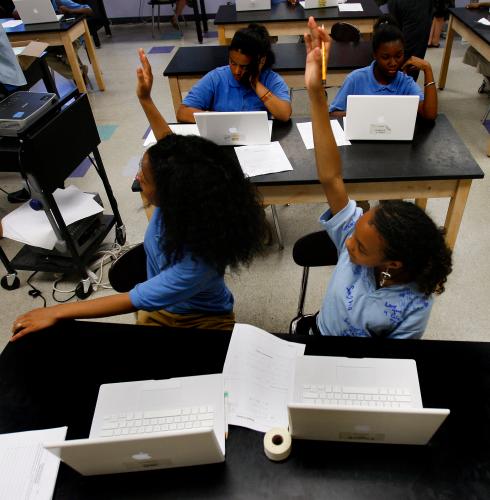Chronic absenteeism has become one of the most prevalent problems facing schools in the aftermath of the COVID-19 pandemic. Between 2018-19 and 2021-22, the percentage of K-12 students who were chronically absent—defined as missing 10% or more of school days, or about 18 days per year—nearly doubled nationally, from 15% to 28%. In 2022-23, rates declined only marginally from this high point and remained well above pre-pandemic levels.
However, despite considerable attention to this problem, research thus far has primarily been limited to tracking changes in state-, district-, or school-level chronic absence rates. While these efforts have established the scale of the problem, there are two key questions they do not answer. First, are the same students chronically absent each year? Second, how many days of school are students missing?
Answering these questions is important because they can reveal the depth, breadth, and persistence of post-pandemic absenteeism. This can help us better understand possible causes and consequences of the rise in absenteeism and, in turn, solutions to the problem.
In a recent study, we used data from North Carolina to examine individual student attendance patterns since the onset of the pandemic. Similar to national trends, North Carolina’s chronic absence rate increased from 14% in 2018-19 to 30% in 2021-22 and remained elevated in 2022-23. Our recent study expanded on this by examining the number of times each student was chronically absent and each student’s total accumulated days absent over the first three post-pandemic years (through 2022-23) among students who were in grades K-6 in 2020-21. For comparison, we tracked the same outcomes for a cohort of pre-pandemic students who were in grades K-6 in 2016-17 (followed through 2018-19). In other words, we compare three years of post-pandemic attendance patterns with three years of pre-pandemic attendance patterns.
Finding 1: The percentage of students experiencing chronic absenteeism at least once, as well as repeatedly, have each increased substantially
Figure 1 shows the percentage of students who were chronically absent for zero, one, two, or all three years in our pre-pandemic (top) and post-pandemic cohort (bottom). It reveals two key takeaways.
First, the percentage of students who were chronically absent at least once increased substantially. Whereas 17% of students were chronically absent in at least one out of the three school years observed pre-pandemic, 40% of students were chronically absent in at least one out of the three post-pandemic school years. This shows that post-pandemic chronic absenteeism has been experienced by a broader set of students than snapshots of single-year chronic absence rates might suggest.
Second, there have been even greater relative increases in students experiencing chronic absenteeism repeatedly. The percentage of students who were chronically absent in at least two of three years increased from seven percent to 20%, while the percentage chronically absent all three years increased from 2.4% to 7.8%. Thus, while chronic absenteeism has been widespread, there is also a sizable group of students who have become persistently chronically absent, which may result in more serious consequences.
In addition, we found increases in these rates across all types of schools and student subgroups. However, increases were greater at schools with higher percentages of economically disadvantaged students and among Black and Hispanic students compared to white students.
Finding 2: Some post-pandemic students have accumulated especially high absence totals
Figure 2 shows the total number of absences accumulated by students across the three pre-pandemic years (blue) as compared to students across the three post-pandemic years (orange). Bars show the total number of absences at selected points of each cohort’s distribution, ranging from the 10th through 95th percentiles. For example, the third pair of bars show the median number of total absences in the pre-pandemic cohort vs. the post-pandemic cohort.
We highlight two key takeaways. First, absences are higher at every point of the distribution post-pandemic, but in many cases gaps are modest. For example, the 10th percentile increased by only three days in total (six vs. nine days), or one day per year, from pre- to post-pandemic. The median increased by nine total days (20 vs. 29 days), or three days per year.
By comparison, gaps are much larger at the upper end of the distribution. The 95th percentile increased from 61 to 111 total absences—or from an average of 20 to 37 absences per year. This means that the five percent of students with the highest absence totals post-pandemic missed more than 20% of all school days over these three years, twice as much as it takes to be considered chronically absent in any single year.
We still have a lot to learn about post-pandemic absenteeism
These results show that different students are facing attendance-related challenges of different severity and duration. Some students are missing just a few more days of school per year, some have transiently experienced chronic absenteeism, and some have become deeply and persistently absent. This may help explain why clear causes of the increase in absenteeism have not yet been identified—that is, no single explanation may suffice to explain the rise in absenteeism across all students.
Our results add support to the call for multitiered approaches to address absenteeism. To return to pre-pandemic attendance levels, education leaders cannot focus only on chronic absence rates, but must also address increases in absenteeism occurring below the chronic absence threshold as well as persistent levels of absenteeism extending far beyond this threshold.
Within this framework, lower-tier interventions tend to be light touch but have broad reach. For example, to address students’ and families’ reported increased comfort with missing school, school leaders might aim to create more engaging in-school experiences—and communicate the value of those experiences to students and families—to encourage attendance.
On the other hand, deep levels of absenteeism may require high-intensity intervention, where attendance teams work individually with students and families to address deep-rooted and complex barriers to attendance. Such work may especially be needed to address the rise in severe mental health challenges that may be a key driver of extreme disengagement.
In between, there is a need for interventions that limit the impacts and persistence of a first experience of chronic or near-chronic absenteeism, which may include academic supports to help students catch up from missed instruction, social supports to help students reconnect with peers and teachers, and check-ins with families to ensure attendance barriers have been addressed.
School leaders will need to consider local needs and opportunities to determine specific interventions to implement, but should generally aim to reduce barriers to attendance and authentically increase students’ and families’ positive engagement with school. Efforts to artificially reward attendance through incentives, or to punish absenteeism, often backfire.
However, these considerations still leave several questions unanswered. Do school leaders have sufficient information and resources to identify and address all of these different needs, particularly as state and federal financial support returns to pre-pandemic levels? And can existing interventions meet all students’ needs and be scaled to meet the extent of need post-pandemic?
To address these concerns, continued support from states and the federal government will be needed. Vital investments could include updating data systems to provide more timely, longitudinal information on absenteeism, funding high-intensity interventions, supporting rapid evaluation and refinement of novel interventions, and creating learning networks to ensure actionable findings are quickly disseminated to school leaders.
Overall, the scale of the attendance crisis is vast, touching almost all students and schools to some degree, and some quite severely. Schools have some guides to begin addressing this problem, but continued attention from policymakers, researchers, journalists, families, and students will be needed to ensure a complete attendance recovery for all students and schools.









